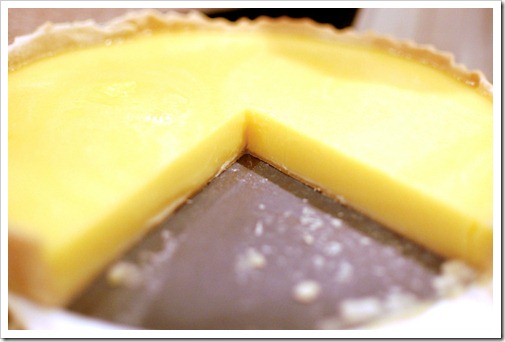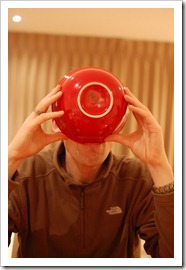Sun 26 Feb 2012
Cooking with Heston
Posted by Clare under Baking, Expats in Ireland, Men and Food
[8] Comments
Though Mountaineering Man loves to eat and [luckily for me] he loves my cooking, he’s not nearly as obsessed about food as I am. And while he’s been doing regular stints in our kitchen for the last few months, he hasn’t exactly morphed into a foodie-o-phile as some may have predicted.
For one, there’s only so much food talk he can handle. Whenever we go on double dates with LikeMamUsedToBake and her husband, he and Mr. LikeMamUsedToBake erect an invisible wall to block out us girls’ hours-long cooking and baking chatter; same goes for when we dine out with Mr. and Mrs. Edible Ireland. The guys are happy to engage in any talk that doesn’t involve food, probably because they all get plenty of culinary conversation from us ladies at home.
And while my idea of the perfect Saturday afternoon involves the latest issue of Bon Appetite magazine, a cup of tea and a fuzzy blanket, MM prefers an episode of Game of Thrones or a few pages of his latest [non-food-related] Chapters Bookstore find. He might “ooooh” and “aaaahhhhh” over the pics of savoury main courses and luscious desserts in the food mags I collect, but his interest doesn’t extend far beyond a few seconds.
So it was a real surprise when we recently discovered a mutual enthusiasm for – wait for it – a cooking show. It took just one episode of Brit chef Heston Blumenthal’s latest Channel 4 gig, How to Cook Like Heston, and MM was hooked. There are no cutesy aprons or frilly cakes on this show; Heston is all about perfecting the art of cooking through science – logic over luck, basically. Each episode features a specific ingredient and a variety of methods on how to bring out the best of said ingredient.
A particularly memorable episode was the one about eggs. In 30 minutes Heston revealed his method for the perfect poached egg and then went on to demonstrate a few of his favourite egg-as-a-main-ingredient dishes. The recipe that caught MM’s undivided attention was Heston’s lemon tart, which as we all know contains a fair few eggs (10 in this particular tart!!). Because many amateur cooks struggle with getting the filling to set properly, Heston developed a fail-safe method and the result was a lemon tart filling with the perfect “wobble.” As the glistening, bubble-free, lemony-yellow slice of tart wobbled on our television screen, we both sat absolutely mesmerized.
“You have to make that!” MM blurted out, surprising himself at the sheer volume of his outburst.
Thankfully there are no major kitchen gadgets necessary for this recipe; all you need is a meat thermometer and a tart pan with a removable bottom. I followed Heston’s instructions to the letter, and the result? An absolutely wonderful lemon tart that is now officially MM’s all-time favourite dessert.
Heston’s Lemon Tart
I will admit that I used Just Roll pastry for this tart because I found Heston’s crust recipe to be a bit tedious, and commenters on various food forums stated they found it no better than a regular ol’ crust. It’s up to you what you use of course but because the filling takes some time and effort using store-bought pastry can save you some time.
For the pastry
· 300g plain flour
· 150g unsalted butter
· ½ tsp salt
· 120g icing sugar
· 3 large egg yolks
· Seeds from ½ vanilla pod
· Finely grated zest of ½ lemon
· 1 egg for the egg wash
For the filling
· Finely grated zest and juice of 5 lemons
· 300ml double cream
· 390g white caster sugar
· 9 large eggs
· 1 large egg yolk
Method
1. Using a mixer fitted with a paddle attachment, mix the flour, butter and salt on low speed until it becomes a sand like texture (approximately 2-3 minutes).
2. In the meantime, in a tall container blitz together the icing sugar and egg yolks with a hand blender.
3. Add the vanilla seeds and lemon zest to the egg yolk mixture and then add to the bowl in the mixer and continue to mix on low speed until fully combined and a very soft dough has formed (approximately 3-5 minutes).
4. Mould the dough into a flat rectangle and wrap it in clingfilm before placing in the fridge for at least 1 hour.
5. Roll the pastry between two sheets of baking paper to a thickness of 2mm, using two stacked 2 pence coins as guides, then place in the freezer for 30 minutes.
6. Pre-heat the oven to 190ºC/gas mark 5. Line a 26cm tart tin (2.5cm deep) with the pastry making sure to press it into the edges and leaving the pastry hanging over the edge.
7. Take a sheet of baking paper and scrunch it up several times to eliminate any sharp edges. Prick the dough with a fork all over the surface. Place the baking paper on top and add enough coins (or baking beans) to fill the casing ¼ of the way up. Place in the preheated oven to bake for approximately 20 minutes or until fully cooked.
8. In the meantime, mix some of the leftover dough with an egg using a hand blender.
9. After 20 minutes, remove the baking paper and coins and, using a pastry brush, brush the entire surface of the tart with the dough and egg mixture. This ‘liquid pastry’ will ensure that any holes will be sealed. Return the tart to the oven for an additional 10 minutes.
10. Remove the tart from the oven and allow to cool completely.
11. When ready to bake, preheat the oven to 120ºC/gas mark ½. Place the baked pastry case in the oven to warm up.
12. Put all the filling ingredients into a bowl and mix together using a spatula. Place the bowl over a saucepan of simmering water and allow to warm up until the temperature reaches 60ºC. At this point, strain the mixture through a fine sieve into a jug. With a spoon, remove the bubbles from the surface of the liquid.
13. Slide the oven rack out a bit, then pour the mixture into the warm pastry case inside the oven. Fill the case to the top, slide the rack carefully back in, and bake the tart for approximately 25 minutes or until the temperature of the filling reaches 70ºC. Allow to cool completely at room temperature.
14. Just before serving, trim the overhanging pastry by running a sharp knife round the top of the tart tin and discard.







There should be a step 15 here. ‘Collapse in ecstasy at the overwhelming glory of your creation’.
HAHA! MM’s comment is cracking me up! In all seriousness, this looks ridiculously, freakishly perfect. Nice!
MM sounds a lot like my S. Funny seeing copies of magazines I have in the pix! So, the way you described Heston, he sounds a little like Alton Brown (?).
I love Heston, but I didn’t know he had a show! I made his chili recipe years ago; it was very difficult but very good.
Hi Clare! Just found your lovely blog. I remember 21 years ago coming to Ireland. Those first years were a tough adjustment and my learning curve was steep but over time I settled in, started a family, wrote a couple of books and had an amazing time. Hang in there. I too made a change last year…moved back to the U.S. for a two year stint. That’s a whole different adjustment!! I’m starting to write about the differences between the two cultures and (but that takes guts!!) and about the things I love food, cooking, gardening, raising kids, family etc. Check out my blog and I’ll follow yours. Who knows, maybe we can exchange a fair bit of sage knowledge with each other!! (pun intended) xo Kim
Love your blog and reading about Ireland. Would you like to do a guest post for NanaHood? Visit me and see what you think.
Teresa
Just found your site and I’m hooked! I lived in Dublin from 2002 to 2006 before moving back to the States with my then Irish boyfriend (now Irish husband) and I can relate to soooo much of what you’re going through! And Heston Blumenthal– what a Food Beast, he’s the best. Fingers crossed we get his show here stateside (especially with the current Gordon Ramsay overload) Thanks for posting and looking forward to checking back for more 🙂
I came across your blog today and enjoyed my visit here. I have never been to Ireland, but I hope that perhaps one day I will have the opportunity.